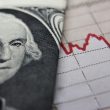by Brian S. Wesbury – Chief Economistm & Robert Stein, CFA – Deputy Chief Economist, First Trust Portfolios
Predicting stock values in 2023 is tough. Unprecedented actions during COVID leaves a wide range of possible outcomes.
Let us explain.
As always, we start out with our Capitalized Profits Model. That model takes a government measure of nationwide profits from the GDP report, discounted by the 10-year US Treasury yield, to calculate fair value for stocks. These data go back to the early 1950s, so almost seventy years. Our measure of profits, which excludes the profits earned by the Federal Reserve system, were up 2.0% in the third quarter, are up 7.8% from a year ago, and are up 23.4% versus the pre-COVID peak. One interesting thing to think about is that while profits rose 7.8% during the year ending in Q3, the GDP Price Index was up 7.1%. Very slow growth in inflation-adjusted profits and higher interest rates combined to push stock values down in 2022.
Using a 10-year Treasury yield of 3.6% (near the Friday close) to discount profits suggests the S&P 500 index is fairly valued at about 3,700. At a 10-year Treasury yield of 4.0%, fair value would be down to 3,350. Fair value for the S&P 500 index would also be about 3,350 if the 10-year yield stays at 3.6% and profits go down 10%, which is what we’d expect to happen in a recession.
What happens if the 10-year yield goes up to 4.0% AND we get a recession? Then fair value would be 3,000. The problem with this scenario is that if we do get a recession, the 10-year yield is unlikely to stay as high as 4.0%. So, it appears that there will be no double-whammy for stocks. However, if even one of these downside risks occurs – higher rates or a profits recession – and fair value drops, even temporarily to 3,350, then stocks will likely spend some time below 3,350, just because stocks always vary above and below actual fair value. That suggests a low for the S&P 500 of about 3,200.
Our forecast is that the US economy enters a recession around mid-2023, for two reasons. First, we never fully felt the impact of lockdowns because we flooded the system with liquidity and borrowed money. Second, monetary policy is now in reverse. And a monetary policy tight enough to slow inflation is likely to generate a recession, as well. It’s hard to see the Fed going from very rapid M2 growth in 2020-21 to essentially zero M2 growth in 2022 without the economy, at least temporarily, hitting a brick wall.
However, stocks are likely to bottom within the first few months of the recession as investors realize this is not another Financial Panic like in 2008-09. That would give stocks room for a rally late in the year even if a recession continues, as equities see the light at the end of the tunnel.
As a result, we are comfortable with a forecast of the S&P 500 finishing next year around 3,900 with the Dow Jones Industrials Average at about 33,000. Not much change from where we are today.
Obviously, if it turns out that the Chairman Powell and the Federal Reserve have engineered a soft landing – no recession in 2023 and with the market ending 2023 confident of not having a recession in 2024 – then stocks should rally substantially in 2023 and easily beat our S&P 500 target of 3,900. By contrast, if it turns out a recession starts later in 2023, providing less time for a rally from the bottom, or if a recession turns deeper than we expect, then stocks could finish 2023 substantially below 3,900.
The bottom line is that while stocks suffered this year from higher interest rates, the greatest headwind in 2023 should be lower profits. We expect the next bull market will be prolonged and strong. But, for the time being, the economy still needs to pay a price for the massive artificial stimulus of 2020-21. Part of that bill came due this year and we think the rest comes due in 2023.
Brian S. Wesbury – Chief Economist
Robert Stein, CFA – Deputy Chief Economist
Click here for a PDF version














